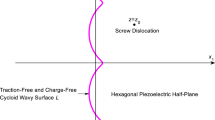Abstract
We study the interaction between a screw dislocation and a traction-free periodic cycloid wavy surface under uniform remote anti-plane stress. A closed-form solution to the interaction problem is derived using conformal mapping and the image method. The image force acting on the screw dislocation is obtained by applying the Peach–Koehler formula. In the case of a cusped cycloid surface, we determine the mode III stress intensity factors at the cusp tips. Criteria for the emission of the screw dislocation from sharp and blunt cusp tips are established.







Similar content being viewed by others
References
Gao, H., Nix, W.D.: Surface roughening of heteroepitaxial thin films. Annu. Rev. Mater. Sci. 29, 173–209 (1999)
Jesson, D.E., Chen, K.M., Pennycook, S.J., Thundat, T., Warmack, R.J.: Crack-like sources of dislocation nucleation and multiplication in thin films. Science 268(5214), 1161–1163 (1995)
Chiu, C.H., Gao, H.: Stress singularities along a cycloid rough surface. Int. J. Solids Struct. 30, 2983–3012 (1993)
Fan, H., Xiao, Z.M.: Dislocation interacting with a slightly wavy interface. Mech. Mater. 40(1), 2137–2161 (1996)
Xiao, Z.M., Chen, B.J., Steele, C.R.: An edge dislocation interacting with a slightly wavy interface. Int. J. Eng. Sci. 40, 2137–2161 (2002)
Lubarda, V.A.: Dislocation Burgers vector and the Peach–Koehler force: a review. J. Mater. Res. Tech. 8, 1550–1565 (2018)
Dundurs, J.: Elastic interaction of dislocations with inhomogeneities. In: Mura, T. (ed.) Mathematical theory of dislocations, pp. 70–115. American Society of Mechanical Engineers, New York (1969)
Head, A.K.: The interaction of dislocations and boundaries. Philos. Mag. 44, 92–94 (1953)
Rice, J.R., Thomson, R.: Ductile versus brittle behaviour of crystals. Philos. Mag. 29, 73–97 (1974)
Majumdar, B.S., Burns, S.J.: Crack tip shielding-an elastic theory of dislocations and dislocation arrays near a sharp crack. Acta Metall. 29, 579–588 (1981)
Ting, T.C.T.: Anisotropic Elasticity-Theory and Applications. Oxford University Press, New York (1996)
Acknowledgements
This work is supported by a Discovery Grant from the Natural Sciences and Engineering Research Council of Canada (Grant No: RGPIN – 2017 - 03716115112).
Author information
Authors and Affiliations
Corresponding authors
Additional information
Publisher's Note
Springer Nature remains neutral with regard to jurisdictional claims in published maps and institutional affiliations.
Rights and permissions
About this article
Cite this article
Wang, X., Schiavone, P. A screw dislocation interacting with a cycloid rough surface. Acta Mech 232, 2417–2423 (2021). https://doi.org/10.1007/s00707-021-02961-2
Received:
Revised:
Accepted:
Published:
Issue Date:
DOI: https://doi.org/10.1007/s00707-021-02961-2



